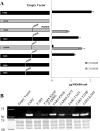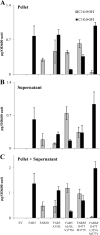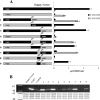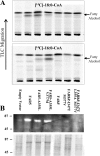Identification of amino acids conferring chain length substrate specificities on fatty alcohol-forming reductases FAR5 and FAR8 from Arabidopsis thaliana
- PMID: 24005667
- PMCID: PMC3798499
- DOI: 10.1074/jbc.M113.499715
Identification of amino acids conferring chain length substrate specificities on fatty alcohol-forming reductases FAR5 and FAR8 from Arabidopsis thaliana
Abstract
Fatty alcohols play a variety of biological roles in all kingdoms of life. Fatty acyl reductase (FAR) enzymes catalyze the reduction of fatty acyl-coenzyme A (CoA) or fatty acyl-acyl carrier protein substrates to primary fatty alcohols. FAR enzymes have distinct substrate specificities with regard to chain length and degree of saturation. FAR5 (At3g44550) and FAR8 (At3g44560) from Arabidopsis thaliana are 85% identical at the amino acid level and are of equal length, but they possess distinct specificities for 18:0 or 16:0 acyl chain length, respectively. We used Saccharomyces cerevisiae as a heterologous expression system to assess FAR substrate specificity determinants. We identified individual amino acids that affect protein levels or 16:0-CoA versus 18:0-CoA specificity by expressing in yeast FAR5 and FAR8 domain-swap chimeras and site-specific mutants. We found that a threonine at position 347 and a serine at position 363 were important for high FAR5 and FAR8 protein accumulation in yeast and thus are likely important for protein folding and stability. Amino acids at positions 355 and 377 were important for dictating 16:0-CoA versus 18:0-CoA chain length specificity. Simultaneously converting alanine 355 and valine 377 of FAR5 to the corresponding FAR8 residues, leucine and methionine, respectively, almost fully converted FAR5 specificity from 18:0-CoA to 16:0-CoA. The reciprocal amino acid conversions, L355A and M377V, made in the active FAR8-S363P mutant background converted its specificity from 16:0-CoA to 18:0-CoA. This study is an important advancement in the engineering of highly active FAR proteins with desired specificities for the production of fatty alcohols with industrial value.
Keywords: Enzyme Structure; Fatty Acyl Reductase; Fatty Alcohol; Lipid Metabolism; Plant Biochemistry; Protein Engineering; Site-directed Mutagenesis.
Figures







Similar articles
-
Three Arabidopsis fatty acyl-coenzyme A reductases, FAR1, FAR4, and FAR5, generate primary fatty alcohols associated with suberin deposition.Plant Physiol. 2010 Aug;153(4):1539-54. doi: 10.1104/pp.110.158238. Epub 2010 Jun 22. Plant Physiol. 2010. PMID: 20571114 Free PMC article.
-
Biochemical characterization of a chloroplast localized fatty acid reductase from Arabidopsis thaliana.Biochim Biophys Acta. 2012 Sep;1821(9):1244-55. doi: 10.1016/j.bbalip.2011.10.019. Epub 2011 Nov 30. Biochim Biophys Acta. 2012. PMID: 22166367
-
Identification of an Arabidopsis fatty alcohol:caffeoyl-Coenzyme A acyltransferase required for the synthesis of alkyl hydroxycinnamates in root waxes.Plant Physiol. 2012 Sep;160(1):237-48. doi: 10.1104/pp.112.201822. Epub 2012 Jul 13. Plant Physiol. 2012. PMID: 22797656 Free PMC article.
-
Plant fatty acyl reductases: enzymes generating fatty alcohols for protective layers with potential for industrial applications.Plant Sci. 2012 Sep;193-194:28-38. doi: 10.1016/j.plantsci.2012.05.002. Epub 2012 May 16. Plant Sci. 2012. PMID: 22794916 Review.
-
Enzymatic reduction of fatty acids and acyl-CoAs to long chain aldehydes and alcohols.Experientia. 1985 Jun 15;41(6):707-13. doi: 10.1007/BF02012564. Experientia. 1985. PMID: 3891397 Review.
Cited by
-
Three TaFAR genes function in the biosynthesis of primary alcohols and the response to abiotic stresses in Triticum aestivum.Sci Rep. 2016 Apr 26;6:25008. doi: 10.1038/srep25008. Sci Rep. 2016. PMID: 27112792 Free PMC article.
-
The production of wax esters in transgenic plants: towards a sustainable source of bio-lubricants.J Exp Bot. 2022 May 13;73(9):2817-2834. doi: 10.1093/jxb/erac046. J Exp Bot. 2022. PMID: 35560197 Free PMC article. Review.
-
Direct production of fatty alcohols from glucose using engineered strains of Yarrowia lipolytica.Metab Eng Commun. 2019 Oct 31;10:e00105. doi: 10.1016/j.mec.2019.e00105. eCollection 2020 Jun. Metab Eng Commun. 2019. PMID: 32547923 Free PMC article.
-
Characterization of the Fatty Acyl-CoA Reductase (FAR) Gene Family and Its Response to Abiotic Stress in Rice (Oryza sativa L.).Plants (Basel). 2024 Apr 1;13(7):1010. doi: 10.3390/plants13071010. Plants (Basel). 2024. PMID: 38611539 Free PMC article.
-
Genome‑wide identification of the cotton FAR gene family reveals GhFAR3 as a positive regulator of Verticillium dahliae resistance.BMC Plant Biol. 2025 Jul 7;25(1):887. doi: 10.1186/s12870-025-06908-w. BMC Plant Biol. 2025. PMID: 40624479 Free PMC article.
References
-
- Rowland O., Domergue F. (2012) Plant fatty acyl reductases: enzymes generating fatty alcohols for protective layers with potential for industrial applications. Plant Sci. 193, 28–38 - PubMed
-
- Antia N. J., Lee R. F., Nevenzel J. C., Cheng J. Y. (1974) Wax ester production by the marine cryptomonad Chroomonas salina grown photoheterotrophically on glycerol. J. Protozool. 21, 768–771 - PubMed
-
- Teerawanichpan P., Robertson A. J., Qiu X. (2010) A fatty acyl-CoA reductase highly expressed in the head of honey bee (Apis mellifera) involves biosynthesis of a wide range of aliphatic fatty alcohols. Insect Biochem. Mol. Biol. 40, 641–649 - PubMed
Publication types
MeSH terms
Substances
LinkOut - more resources
Full Text Sources
Other Literature Sources
Molecular Biology Databases

